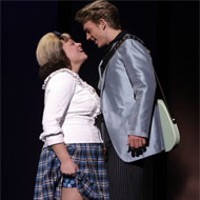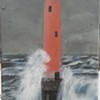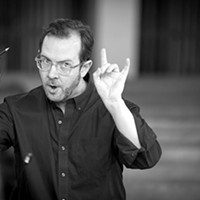Over The (Big) Top
Blowing the Whistle on Ringmasters, Animals, Sawdust, and...Drum Rolls
By Perry TannenbaumSomeone at the door. Only Zoe responds, ushering in the enigmatic intruder. He's dressed in a mustard-and-blue overcoat, eerily aglow in the hypnotic light, a blue bowler hat in one hand and an umbrella in the other. Striding to the middle of the living room, he does a most curious thing: instead of closing the blue, translucent umbrella, he opens it.
All of which accents the most absurd attribute of our silent visitor. No man could need an umbrella less. He has no head!
Inspired by the surreal paintings of Rene Magritte, liberally laced with Parisian attitude and ennui, Quidam is like no circus you've ever seen. No sawdust. No animals. No drum rolls. And that guy with the whistle and the bad haircut is not so much a ringmaster as a crazed refugee from a Brecht drama.
Quidam is even strange for Cirque du Soleil, the Montreal-based company that began breaking the mold for mod circus productions in 1984. They began as a ragtag team of street performers unbound by previous concepts of what a circus should be. Guy Laliberte recognized and organized the talent of the streets, and the Canadian government bankrolled his first Cirque du Soleil production.
But the groundbreaking concept probably did not come before the strange fire-eating, stiltwalking accordion player visited his favorite tarot card reader.
Since Cirque's first triumph, they've successfully invaded New York, L.A., and Disneyworld. Not to mention Europe, Asia, New Zealand, and Biloxi.
The main corps of Quebeckers have always known what they're about. As early as 1987, when they first premiered in the US, they were brashly calling their new LA show We Reinvent the Circus. Vegas was just as enchanted as Disney.
But Laliberte and his inner circle didn't answer Sin City's call until the times -- and the vision -- were right. Cirque's longest-running show, Mystere at Treasure Island, was at the vanguard of a monumental facelift -- aimed at transforming Las Vegas from a haven for honeymooners and high-rollers into a family vacation destination.
So a whole lot of Cirque style has rubbed off on the new Vegas. And along the way, as Cirque became more successful, elements of Vegas and Disney rubbed off on them.
They are big and expensive. Currently there are some 2100 employees on the Cirque payroll, including some 700 staffers at their international HQ in Montreal and more than 500 artists.
And they can definitely juggle. Seven different Cirque shows are up and running right now -- four on tour, two in Vegas, and one in Orlando. Artsy and enterprising as Cirque du Soleil is, there's still a retro side to this Canadian juggernaut. While Ringling Brothers swore off that familiar icon of touring circuses -- the big top -- way back in 1956, Quidam opens next week at Lowe's Motor Speedway under its blue-and-yellow Grand Chapiteau. Perched on the Speedway infield, this huge tent will accommodate 2,600 - more than either Belk Theater or Ovens Auditorium.
With audience surrounding about 240 degrees of the stage, you can count on sitting fairly close to the action. It's one big ring, not three, with an area of 29,000 square feet.
For all those poetic and retro elements, Quidam is also dazzling and high-tech. Even Gotham critics were wowed, as Cirque Surreal snapped up the Drama Desk Award in 1998 for Unique Theatrical Experience after its New York engagement.
"With success comes money," explains Quidam's artistic director, Serge Roy. "With money comes the possibility of buying new toys or more expensive costumes and building a thing like the conveyer."
Like so much of Quidam, those conveyers -- five of them spanning nearly the entire Chapiteau -- turn the notion of circus upside down. Instead of running in and climbing to the tops of their respective apparatuses, aerial artists arrive overhead, carried along the ceiling of the big top by upside-down trolleys rolling along 120-foot aluminum rails. Down below, no poles or ladders clutter the view.
Dad is floating above us, walking on air, half his head sticking out the other side of the hole in his newspaper. When he disappears, the Ringmaster makes an unintelligible announcement on his bullhorn...The wind swirls moodily, and Zoe sings disconsolate monosyllables in the lonely dark.
Spooky noises and echoing whispers. Warm spotlights pierce the darkness to the mesmerizing spectacle above. A pillar of fiery silk wraps a hooded corpse-like figure. She comes to life, emerging from her chrysalis. Her buttocks are tensed, bulging, uncanny. With spidery speed, she has wrapped the silk around her legs, forming a perfect T as she dangles herself down toward the ground below -- her legs fully split above her torso.
As the haunting violin yields to a wailing electric guitar, the contortionist's interactions with the silk are progressively less liquid and sensuous, more jagged and defiant, until she finally drops to the ground, totally spent. Zoe's mother is among the three women who solemnly carry her away.
"We have the possibility to use the entire space instead of just the stage as a flat scene," Roy elaborates. "And we have the possibility of having that stage rotating because we have a turntable under it."
The turntable is an unabashed steal from Les Miz. In a nod to the Broadway megahit, a drum corps dressed in peasant rags marches onstage for a righteous cameo. While our attention is usually focused on one area of the stage, other subplots and images are constantly flung at us on the margins. Richly suggestive and theatrical.
Says Roy: "If you are thinking, 'Oh, isn't this separating you from what was originally the street performers?' Yes! But there's something that doesn't change. It's the will of the performer to perform. His own skills, his quality of performance, and his ability to transmit that to the public. That's what we will work on the most."
Aside from the aerial contortion in silk, other Quidam exotics include a rope skipping extravaganza, a trio of synchronized aerial hoop riders, a cutesy quartet of diabolo virtuosi flinging Chinese yo-yo's around, and the daring cloud swing, combining trapeze and Spanish web.
More conventional circus fare is sprinkled in the mix. Fifteen Slavic artists perform acrobatic sequences in a banquine act, forming human pyramids. An American gymnast -- in a costume halfway between clown and rock star -- becomes the spokes of a German wheel, performing spins, turns, twists, and gravity-mocking acrobatics. Dad turns out to be Israeli juggler Edward Skwirsky.
It all comes very slickly packaged. Six live musicians play the original Benoit Jutras score. Like any musical spectacle, Quidam boasts the full range and designers and directors behind the scenes. Michel Crete not only designs sets for Cirque, he collaborates in the design of the theaters for the company's permanent installations. Dominique Lemieux came to costume design after beginning as a children's book illustrator. Debra Brown has been choreographing for contortionists like Quidam's silky aerialist, Isabelle Chasse, for over a decade.
Everybody on the Quidam creative team has been with Cirque for at least a decade. That includes director Franco Dragone, who has been with the company since 1985 and is largely responsible for their signature theater-circus synthesis. Director of creation Gilles Ste-Croix, like Laliberte a one-time performer of a stiltwalking act, has been with Cirque since before the beginning, founding the band of stiltwalkers that ultimately evolved into a global powerhouse.
What was conspicuously lacking in the core group's background was circus production experience.
"We had the opportunity of getting money from the government to buy our first big top," Roy recalls. "And that's how it started. We didn't have a background of circus, but we knew people who sometimes worked in circuses and who were performing in circuses with their acts. And we also knew people who were in the theater business. So mixing all we knew, we just became what we were."
Nor does Roy profess that Cirque has a PC aversion to lion tamers, performing pachyderms, and bareback riders.
"You know we did not choose then not to have animals," he confides. "We didn't have enough money to own animals! You have to take care of them -- feed them, transportation, veterinarian, and all that. But then we found a way of doing things our way, and it became what we are today. We decided not to have animals and put more energy in creating a concept.
"Instead of having an MC coming and saying, 'and now, ladies and gentlemen: from Germany ta-rah, ta-rah, ta-rah...' the show starts somewhere and it ends somewhere. And between those two points, there will be a series of images and tableaus. They serve to inspire you as a spectator, not to tell you a story necessarily. It's for you to tell you yourself your own story, inspired by the images we are creating."
And it's Roy, as Quidam artistic director, who must keep the show running smoothly -- and patch things together seamlessly when it threatens to rip apart. Keeping fresh legs on a show that's been running since 1996 isn't easy. Not exploiting animals is nice, but the key to Roy is not exploiting his artists and acrobats.
Road conditions count. So does a nurturing artistic environment. Artists stopping over in Charlotte will get their own apartments instead of getting crammed into double occupancy motel rooms. Troupes of acrobats get more than a calliope accompaniment.
"If you come to work in our circus," Roy stresses, "we're going to work on your act. We're going to put another costume on. We're going to bring in a choreographer to work with you and the people around you. We're going to give you your own music, your own lighting, you see? We're going to put you in a proper environment that respects the entire concept of the show."
Quidam: a nameless passerby, a solitary figure lingering on a street corner, a person rushing past, living lost amidst the crowd. One who cries out, sings and dreams within us all. Transforming an anonymous world into a place of hope and connection. Target: grace in motion. The Target chooses to live in empty space, present and absent at the same time, a companion to the lost girl for a little while.
In a show as richly concepted as Quidam, Cirque du Soleil turns the paradigm of circus production upside down. Normally the company would seek out solo acts and groups, devise an environment that showcases them, adding music in the background, formulating intros, building the tension...cuing the drum rolls.
Soleil also scouts talent around the world, but they have what Roy calls a "big casting department" in Montreal. That's because people need to be found to meet exacting character concepts in new shows spun out by Cirque's creative team -- and to fill openings that suddenly crop up because of injuries, illness, and career moves. On tour, Roy takes on a large share of the troubleshooting.
"We just started Miami," Roy told us back in February. "Before that opened, we transferred from Europe to Miami. In that process, we lost a couple of artists. So to make sure that everything is well-tuned-in and oiled and everything, I'm going to bring the choreographer."
The original choreographer, Debra Brown, answered that SOS. Benoit Jutras' assistant came to work with the band because a new bandleader was on board, along with a new violin player and a new guitar player. On top of that, since Roy was integrating a new act into the mix, the original musical concept had to be adapted to the new talent.
So the original creative team remains involved, but not as closely as they were in 1996. "What's opening the first half is not what you saw four years ago," Roy reveals. "So it's never really boring, like I'm watching the same show and maintaining the quality. It's alive!"
When the headless visitor drops his blue bowler to the floor, there's a sudden clap of thunder and flashes of lightning. Zoe retrieves the hat and runs after the man. But he walks resolutely out into the rain, ignores the girl, leaving his blue bowler -- and his umbrella! -- behind him.
Still singing sweetly, Zoe returns stage center, sits down, and studies her new hat. The Ringmaster and the Target line up behind her, hamming it up impishly, as Zoe remains entranced by the bowler. Emboldened, the Ringmaster sneaks up behind the girl, looming directly behind her as she lifts the blue chapeau over her head. Will the prankster steal the hat before she puts it on?
Although the main goal is to entertain, Quidam stretches the emotional and visual boundaries of circus far beyond their traditional glitz and glee. Costume designer Lemieux has chosen grey as the color she wishes to emphasize, accented by warm hues and metallic tones. And the creative team that already reinvented the circus now strives in Quidam to reinvent themselves.
"When it was time for Quidam," Roy remembers, "they wanted to try and do something else, something different. They wanted to dare to bring a new type of emotion onstage, something a lot more contemporary, something that would dare to talk about anonymity.
"If you've seen the beginning of the show, the little girl starts moving around, and it's obvious that the parents are there, and they're inside their little world. She's trying to get in contact with them, but they don't move. Nothing happens.
"So what is the next sequence, is she dreaming? It's not really important. When a child plays, he's just in the world he's playing. He becomes what it is. When they decided to create Quidam, they wanted to show an emotional state that's not necessarily fun.
"It can be dark. But it's not a dark show."
There's a sudden conjurer's movement from the Ringmaster as the hat rests on Zoe's head for the first time. But instead of snatching the hat, the Ringmaster kneads his arms urgently -- like a crazed conductor giving a downbeat.
And so he is. Violins instantly grow louder, cymbals crash, kettledrums pound gravely, and a full chorus wafts into the soundscape as Zoe resumes singing. Most astoundingly, Zoe's parents rise straight up into the air. Still in their chairs. Still motionless and oblivious. Dad, his shoes left down below, still reads his newspaper. Mom's radio remains in her lap -- and she's still staring expressionlessly. A whole battalion of people marches in slowly from all directions, mysteriously hooded in white suits like clean-up workers at the site of a nuclear disaster. A hatch lifts up in the floor, tumbling the Ringmaster backwards, and a clown-like man peeps out and hands Zoe a pink balloon.
The Ringmaster returns, stomping down on the trapdoor and following Zoe to the front of the stage. Light shines from beneath Dad's abandoned shoes. Music is hushed as gingerly, the Ringmaster steps into Dad's shoes. Tempo quickens...grows raucous...spontaneous...festive.
Our journey of the imagination has begun.*
Speaking of Arts_performance.html
-

Sailing With Hamlet
Jul 20, 2005 -

Proud To Be Plump
Jul 6, 2005 -

Putting The Sell In Cellulite
Jun 29, 2005 - More »
Latest in Performing Arts
More by Perry Tannenbaum
Calendar
-

NEW WINDOW GALLERY-Pat Rhea-ACRYLIC PAINTINGS-April 05-30 2024 VALDESE, NC 28690 @ New Window Gallery/Play It Again Records
- Through April 30, 12 p.m.
-
Derek Hough - Symphony Of Dance @ Ovens Auditorium
-

"Blood Residue Analysis of Paleoamerican Stone Tools in the Carolinas" @ Native American Studies Center
- Fri., April 26, 12-1 p.m.
-

ARTS RENAISSANCE, a GALA supporting the ARTS in South Carolina @ the Columbia Museum of ART
-
 The Piano Guys @ Ovens Auditorium
The Piano Guys @ Ovens Auditorium
-
The death of CAST 5
What really happened to Charlotte's beloved experimental theater company?
-
Jessica Moss Makes the Gantt Center a Safe Zone for Local Artists 2
Flipping the script
-
Charlotte ink 7
Behind the pain with a trio of the Queen City's finest tattoo artists














